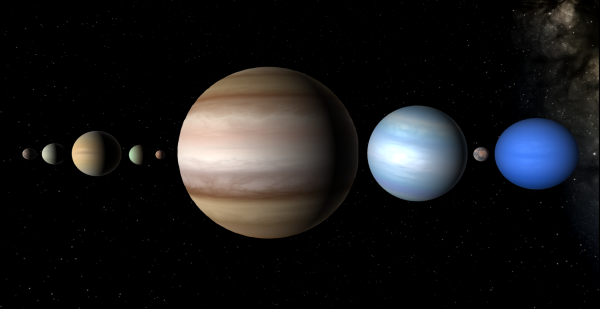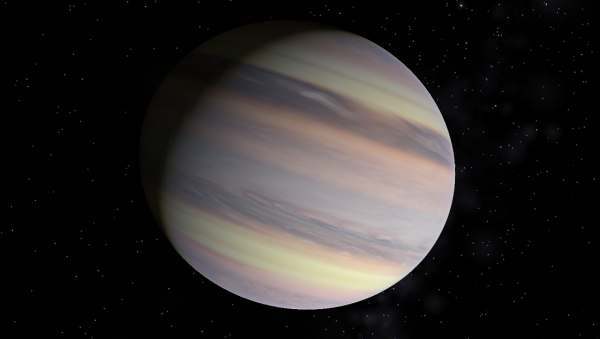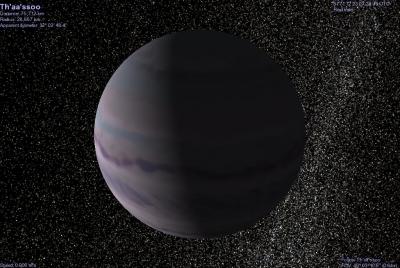BY LETTER
H'tat'sa'thoss (JD 870135)
Galactography > Regions of Space > Middle Regions/Hinter-regions
Galactography > Systems and Worlds > Systems & Worlds G - H
Sophonts > Xenosophonts > To'ul'hs
Galactography > Systems and Worlds > Systems & Worlds G - H
Sophonts > Xenosophonts > To'ul'hs
The system containing Tohul, home planet of the To'ul'hs | |
 Image from Dangerous Safety | |
| The major planets of the H'tat'sa'thoss system | |
H'tat'sa'thoss (JD 870135) - Data Panel | |
| System | Name: H'tat'sa'thoss Location: - Distance from NGC 6633: 11 ly (J2000) - Distance from Sol: 1,235 ly (J2000) - Constellation: Ophiuchus |
|---|---|
| Star | Names: H'tat'sa'thoss, JD 870135, YTS 44290-19101-1 Physical characteristics: - Mass: 2.14E+30 kg (1.074 x Sol) - Radius: 764,520 km (1.098 x Sol) - Luminosity: 1.359 x Sol (bolometric) - Temperature: 5,953 Kelvin - Spectral type: G0 V - Rotation period: 24.4 days - Age: 3.5 billion years |
| 1st planet | Name: Sh'ssol Orbital characteristics: - Semi-major axis: 0.274 AU - Orbital period: 0.138 years - Eccentricity: 0.091 Physical characteristics: - Type: Videntian Terrestrial Hermian LapiMinervan Tundral BrimoArean - Mass: 1.8E+24 kg (0.302 x Earth) - Radius: 4,160 km (0.653 x Earth) - Density: 5,979 kg/m^3 - Mean surface acceleration: 6.95 m/s^2 (0.708 gees) - Rotation period: Tidally-locked - Obliquity: 0.1° - Albedo: 0.36 - Mean surface temperature: 564 K Atmosphere: - Surface pressure: 910 mPa (9.1 µbar) - Composition: 78.2% carbon dioxide, 14.7% argon, 4.9% sulfur dioxide, 1.3% nitrogen, 0.8% water, trace amounts of carbonyl sulfide, sulfur, hydrogen sulfide, carbon monoxide, and neon. Tidally locked world with a thin but corrosive atmosphere; small population of vecs, mostly on the cooler dark side |
| 2nd planet | Name: To'hso'lo Orbital characteristics: - Semi-major axis: 0.696 AU - Orbital period: 0.560 years - Eccentricity: 0.015 Physical characteristics: - Type: AcidiTerrestrial LapiMinervan CapnoCytherean - Mass: 1.13E+25 kg (1.89 x Earth) - Radius: 7,773 km (1.22 x Earth) - Density: 5,738 kg/m^3 - Mean surface acceleration: 12.47 m/s^2 (1.27 gees) - Rotation period: 209 hours - Solar day: 218 hours - Obliquity: 18° - Albedo: 0.79 - Mean surface temperature: 798 K Atmosphere: - Surface pressure: 21.1 MPa (211 bar) - Composition: 94.8% carbon dioxide, 5.2% nitrogen, trace amounts of water, sulfur dioxide, argon, carbon monoxide, neon, helium, and sulfuric acid. Hot venus-like world, with numerous orbiting habitats built from extracted carbon allotropes (population largely To'ul's, toulhumans and human-derived sophonts |
| 3rd planet | Name: K'lo'sho Orbital characteristics: - Semi-major axis: 1.068 AU - Orbital period: 1.065 years - Eccentricity: 0.023 Physical characteristics: - Type: TholiNeptunian CereJotunnian AquaCytherean - Mass: 3.29E+25 kg (5.36 x Earth) - Radius: 15,481 km (2.43 x Earth) - Density: 2,059 kg/m^3 - Mean acceleration at cloud-tops: 8.87 m/s^2 (0.905 gees) - Rotation period: 17.75 hours - Obliquity: 17° - Albedo: 0.43 - Mean surface temperature: 308 K Atmosphere: - Composition: 72.8% hydrogen, 19.3% helium, 5.6% water, 1.8% methane, 0.5% ammonia. K'lo'sho is a superterrestrial gas dwarf/subneptune with a hydrogen-rich atmosphere and a respectable population housed in bubblehabs. An important centre for To'ul'hian academic research into Terragen cultural influences. |
 Image from Steve Bowers | |
| Tohul - 'Home of the To'ul'hs'. The green colour is skyplankton floating in the upper atmosphere's photic zone | |
| 4th planet | Name: Tohul (This name means 'Home of the To'ul'hs' in the local record-keeping language) Orbital characteristics: - Semi-major axis: 245.6 Gm (1.642 AU) - Orbital period: 2.030 years - Eccentricity: 0.018 Physical characteristics: - Type: TholiTerrestrial LapiMinervan EstuaThermal AquaGaian - Mass: 8.74E+24 kg (1.464 x Earth) - Radius: 7,085 km (1.112 x Earth) - Density: 5,870 kg/m^3 - Mean surface acceleration: 11.61 m/s^2 (1.184 gees) - Rotation period: 19.05 hours - Obliquity: 7° - Albedo: 0.48 - Mean insolation: 686 W/m^2 (0.504 x Earth) - Mean surface temperature: 358 K Atmosphere: - Surface pressure: 1.936 MPa (19.36 bar) - Composition: 57.1% carbon dioxide, 23.3% nitrogen, 19.3% oxygen, 0.2% water, 0.1% argon, trace amounts of sulfur dioxide, carbon monoxide, neon, helium, hydrogen, and methane. Tohul is a life-bearing, macrobial world with a high atmospheric water content, the type world of Tohulian worlds all over the galaxy. The planet supports a relatively advanced civilisation that was contacted by Terragen explorers in 4011 AT. |
|---|---|
| 5th planet | Name: H'a'thass Orbital characteristics: - Semi-major axis: 2.322 AU - Orbital period: 3.414 standard years - Eccentricity: 0.065 Physical characteristics: - Type: Terrestrial LapiMinervan Tundral CapnoArean - Mass: 4.89E+23 kg (0.0819 x Earth) - Radius: 3,039 km (0.477 x Earth) - Density: 4,160 kg/m^3 - Mean surface acceleration: 3.53 m/s^2 (0.359 gees) - Rotation period: 27.7 hours - Obliquity: 29° - Albedo: 0.26 - Mean surface temperature: 197 K Atmosphere: - Surface pressure: 455 Pa (4.55 mbar) - Composition: 93.6% carbon dioxide, 3.4% nitrogen, 2.9% argon, 0.1% carbon monoxide, trace amounts of oxygen, water, ammonia, methane, and neon. A small, icy Mars-like world which is home to a significant population of low gravity Terragen sophonts and toulhumans, most of whom are engaged in interaction with, and study of, the numerous To'ul'h surface polities |
 Image from Steve Bowers | |
| Shthossaa, a gas giant in this system | |
| 6th planet | Name: Shthossaa Orbital characteristics: - Semi-major axis: 8.45 AU - Orbital period: 23.7 years - Eccentricity: 0.044 Physical characteristics: - Type: AmmoJovian HydrogeoBarian - Mass: 2.71E+27 kg (453 x Earth) - Radius: 70,208 km (11.02 x Earth) - Density: 1,869 kg/m^3 - Mean acceleration at cloud-tops: 35.79 m/s^2 (3.65 gees) - Rotation period: 8.1 hours - Obliquity: 25° - Albedo: 0.34 - Mean surface temperature: 171 K Atmosphere: - Composition: 90.7% hydrogen, 9.0% helium, 0.3% methane. A large gas giant with a very rapid rotation; the upper cloud layers are too turbulent to comfortably support modosophont bubblehabs, but the planet is host to several thousand transapient nodes embedded in the deeper atmospheric layers. In the Current Era most of these nodes contain entities derived from ascended To'ul'h individuals. |
|---|
 Image from Steve Bowers | |
| Th'aa'ssoo, a cryojovian in the Tohul system (false color) | |
| 7th planet | Name: Th'aa'ssoo Orbital characteristics: - Semi-major axis: 14.83 AU - Orbital period: 55.1 years - Eccentricity: 0.053 Physical characteristics: - Type: MethoNeptunian GeliJotunnian HydrogeoBarian - Mass: 1.5E+26 kg (25.04 x Earth) - Radius: 35,486 km (5.57 x Earth) - Density: 799 kg/m^3 - Mean acceleration at cloud-tops: 7.79 m/s^2 (0.794 gees) - Rotation period: 15.4 hours - Obliquity: 19.5° - Albedo: 0.56 - Mean surface temperature: 80.5 K Atmosphere: - Composition: 84.7% hydrogen, 13.2% helium, 1.9% methane, 0.1% water, 0.1% ammonia. An ice giant with a turbulent atmosphere. Host to numerous bubblehabs, including a small contingent of Muuh |
|---|---|
| 8th planet | Name: J'ha'sothaa Orbital characteristics: - Semi-major axis: 20.84 AU - Orbital period: 91.8 years - Eccentricity: 0.18 Physical characteristics: - Type: TholiTerrestrial CereRhean LacuTundral AzoGaian - Mass: 1.53E+24 kg (0.257 x Earth) - Radius: 4,925 km (0.773 x Earth) - Density: 3,067 kg/m^3 - Mean surface acceleration: 4.22 m/s^2 (0.431 gees) - Rotation period: 178 hours - Obliquity: 55° - Albedo: 0.31 - Mean surface temperature: 71.87 K Atmosphere: - Surface pressure: 51.8 kPa (518 mbar) - Composition: 94.3% nitrogen, 4.4% carbon monoxide, 0.6% hydrogen, 0.5% neon, 0.2% methane, trace amounts of helium, oxygen, nitric oxide, argon, and hydrogen cyanide. An icy world with nitrogen seas, notable for research into pantropic modification of To'ul'hs for extreme environments |
| 9th planet | Name: K'at'sa'thos'kul Orbital characteristics: - Semi-major axis: 42.4 AU - Orbital period: 266 years - Eccentricity: 0.26 Physical characteristics: - Type: CryoNeptunian GeliJotunnian AquaCytherean - Mass: 8.62E+25 kg (14.43 x Earth) - Radius: 25,803 km (4.05 x Earth) - Density: 1,198 kg/m^3 - Mean surface acceleration: 8.56 m/s^2 (0.873 gees) - Rotation period: 16.9 hours - Obliquity: 14° - Albedo: 0.29 - Mean surface temperature: 58 K Atmosphere: - Composition: 82.4% hydrogen, 14.9% helium, 2.4% methane, 0.2% water, 0.1% ammonia. Ice giant/neptunian in the process of being converted into a To'hulian Neptune Brain |
Related Articles
Appears in Topics
Development Notes
Text by Dangerous Safety, The Astronomer, QuantumJack1
Additional material by Steve Bowers
Initially published on 21 June 2020.
Additional material by Steve Bowers
Initially published on 21 June 2020.






